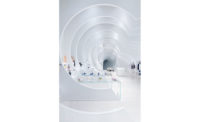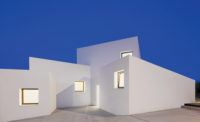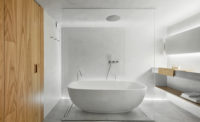Palma de Majorca, Spain
Founded in 1879 by German entrepreneur Guillermo Krug, the Relojería Alemana’s first jewelry store still stands on a corner of the Carrer del Colón, amid the labyrinthine tangle of cobbled lanes and alleyways that make up the quaint historical district of Palma de Majorca, Spain. Owned and operated by the Fuster family since 1922, the shop occupies the first two floors of a residential-style six-story building. Above it, tucked among the remaining four stories, along with the company’s workshops, a new office designed by the Palma Madrid-based studio OHLAB demonstrates the owner’s commitment to the 21st century and contemporary design.
The top-floor office, which opened in November of 2015, is a surprising contrast to the classical, ornamental interiors of the store below. OHLAB’s cofounders and partners Jaime Oliver and Paloma Hernaiz, who have been working with Relojería Alemana for nearly five years, devised a simple concept that responds to both the client’s comprehensive brief—which even covered the square footage of storage space—and an irregular floor plan.
Without resorting to physical partitions, the architects divided the 1,400-square-foot space into two contrasting areas through a clever use of color and materials. They located the open, rectangular workspace along a continuous span of the building’s facade. Then they carved four wood-lined niches into the opposite wall, offsetting the irregular configuration of the rear elevation. This allowed Oliver and Hernaiz to bring natural light into all the areas, as well as to stretch functionality.
OHLAB’S previous designs for Relojería Alemana stores in nearby Port Adriano (2012) and Paseo del Borne (2013), also in Palma, refreshed the image of the 135-year-old brand, positioning it for today’s market. In the office, the wall that separates the work and informal areas is clad in chromed stainless steel with a mirror finish, a direct nod to these award-winning boutiques. “We really wanted to bring a striking element that was part of the two stores,” Hernaiz says. “The mirror works perfectly for practical as well as conceptual reasons.” Indeed, the mirrors not only make the office feel bigger but help reflect light.
In-depth research into the modern workplace, coupled with the familiarity of the brand, allowed the firm to enrich the client’s mandate with outside-the-box solutions. For instance, instead of being a tedious office essential, the desks are a focal point. The architects distributed 14 workstations on one 37-foot-long by 4-foot-wide communal table that extends into the director’s boardroom, where it becomes a meeting table. A glass wall separating the two functions provides privacy for meetings while allowing for visual continuity.
The design team balanced the neutral, open space for focused work with informal areas. “At the beginning, the client was skeptical about the amount of space we were giving to the kitchen,” Oliver says. “Now they understand. Employees use the kitchen counter for different types of work and informal meetings.” Besides the kitchen, the niches house the entrance and reception area, a walk-in vault, and the director’s office, which has an adjacent private restroom.
Like much of OHLAB’s work, nothing was left to chance in this small-scale project. “Besides the fact that we love industrial design, the advantage of designing bespoke elements is that we maintain full control of the project,” Hernaiz says. This control extends to the custom workspace lighting (an aluminum fixture with LED strips), the kitchen counter, restroom sinks, and the oak wood panels that line the cove walls and ceilings. These panels consist of wood ribs that disguise the door openings throughout the walls, and conceal the lighting and ventilation systems in the ceiling, resulting in a clean, continuous finish. Similarly, contemporary furniture was carefully selected to complement the design. Kitchen stools by E-15, Eames Vitra office chairs, and a Matthew Hilton desk produced by Portuguese company De La Espada contribute to a playful but practical space.
Just as the architects’ earlier schemes for the Relojería Alemana boutiques looked to redefine the traditional store and dissolve barriers between outside and inside, and customer and staff, so the new office looks to redefine the traditional workplace and dissolve barriers, this time between life and work, and staff and employers.
Oliver and Hernaiz always respond thoughtfully to their clients’ needs, while also challenging them in positive ways. According to the partners, “The name of our studio is no coincidence.” Their “lab” aims to find each project’s specific design language instead of furthering its own individual style.
OHLAB is helping Relojería Alemana redefine its future while honoring its past. It is now working on revamping the workshops and original store—integrating the brand’s 21st-century image within company headquarters. Construction is set to begin in 2017.
PeopleArchitect: OHLAB / Oliver Hernaiz Architecture Lab C/Manuel Guasp 6A 07006 Palma De Mallorca
Personnel in architect's firm who should receive special credit: OHLAB team: Paloma Hernaiz and Jaime Oliver with Rebeca Lavín, Marina Esteban
Architect of record: Paloma Hernaiz and Jaime Oliver
Interior designer: OHLAB General contractor: Lagares
Photographer: José Hevia
|
ProductsWindows Metal frame: Aluminum frames Schüco Doors Wood doors: Custom made wood doors by Lagares Interior Finishes Cabinetwork and custom woodwork: Woodwork by Lagares Paneling: Chromed mirrored stainless steel by inoxincolor Furnishings Chairs: Kartell,Thonet,Vitra, E15, Tables: Viccarbe, Delaespada Lighting Interior ambient lighting: Santa and Cole, Louis Poulsen Tasklighting: Custom designed by OHLAB and produced by Lagares Conveyance Elevators/escalators: MALIFT |












